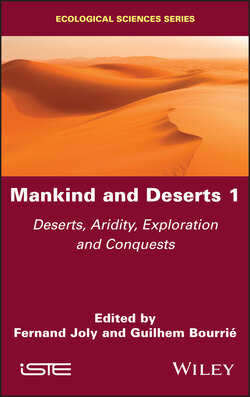Читать книгу Mankind and Deserts 1 - Группа авторов - Страница 12
1.4. Deserts of the world
ОглавлениеIf it is not easy to define a desert, it is even harder to establish its boundaries. Most often, we see a progressive transition from the humid to the arid and then onto the desertic. These nuances are themselves limited by fuzzy boundaries, with capes, islands and enclaves that change with seasons and the passing of the years. We can ascribe certain properties to them that are more or less measurable: climatic (the abundance of rain, indicators of aridity), hydrological (density of drainage, flow indices, endorheism, arheism), biological (plant cover, composition of the flora, adaptation to dry conditions, endemism9), morphological (relief, geodynamic systems) or even economic (presence or absence of cultivation, the need to use irrigation). Each of these arguments or criteria is both valid and disputable, but they are only truly meaningful when combined with the others in an overall network of interdependencies that make up the desert ecosystem.
Thus, citing a specific figure for the area covered by deserts around the world is both an illusory and approximate exercise. This being said, we can broadly say that deserts (in the broadest sense) cover about a third of the area made up by the continents, without taking into account frozen deserts. They are distributed across the globe in inter-tropical and temperate regions, along three basic axes (Figure 1.1):
1) the Afro-Asiatic Eremic diagonal10 that includes the Sahara and the deserts in Asia;
2) the North and South American Eremic diagonals;
3) the isolated deserts in the Southern Hemisphere: Northeast Brazil, South Africa, Madagascar and Australia.
Figure 1.1. Arid regions around the world as per (Meigs 1977–1979), modified
How can it be that, in the age of air travel, widespread tourism, television and the Internet, we still so often have such a fuzzy, conventional and mythical image of the deserts? There has certainly been progress in gaining direct knowledge of the deserts, but this knowledge itself has spread very slowly and imperfectly to non-desert regions. The difficulties around entering and traveling through the desert can be blamed for this slow dissemination, as well as the risks inherent to these regions. Man has traveled across the deserts for centuries out of necessity and as a result of certain events (military, political or economic), rather than through a desire to discover or gain knowledge. The merchants and travelers would follow linear paths marked by water points. They would rarely deviate from these paths, for fear of losing themselves and dying in the desert. Modern automobiles (not counting those used in the rallies) can cover in one hour the distance that a camel would take a day to travel. Those who make these journeys today do so at a speed that allows them to grasp only the most superficial of information. Views from planes or satellite images are always difficult to decipher. Tourists, reporters and artists, who are very demanding, prefer the picturesque or sensational over banal reality. There is an increasing number of scientists in this field, but they have a very limited audience. For all of these reasons, the image that the public receives of the desert is partial and varies widely depending on the source. The varying levels of reliability of the information and the unequal distribution of this knowledge go a great way toward explaining the obscurity, mystery and legends that deserts are veiled in even today.
